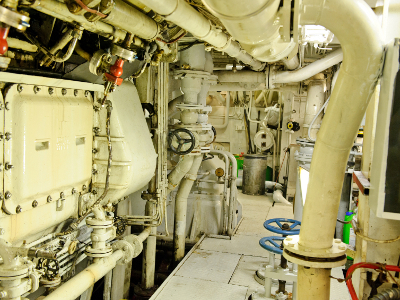
Vast and varied types of marine vessel sail our seas, from giant military and petro-chemical vessels through to commercial and leisure vessels of all sizes. While their purposes vary, one factor common to them all is fire risk and, despite the irony of being surrounded by water, this risk is very real.
Fire Risks on Marine Vessels
Crew and passengers have very limited means of fire escape aboard ship and the chances of rescuing any valuable cargo is slim to none. It’s therefore essential to detect fire at the precombustion stage to safeguard against the outbreak of flames.
Typical fire risks on marine vessels include:
|
|
|
 Linear Heat Detection
Linear Heat Detection
One fire detection method that has proven particularly effective at sea is linear heat detection.
Linear heat detectors, such as Fyreline, use heat sensing cable to provide localised fire detection, often before ignition occurs. Where there is excess heat, an ultra heat-sensitive coating on the linear cable will disintegrate at a pre-determined temperature causing two wires in the cable to touch and create a short. This short sends a signal to the control panel which allows the location of the potential fire to be measured accurately, allowing for faster identification and management.
Very early fire detection such as this can save lives (and livelihoods) and also proves to be very cost-effective as damaged sections of cable can be easily replaced with the use of junction boxes and short lengths of new cable.
Applications Onboard Ship
The most common use of linear heat detection is the protection of engine bays. Fire hazards abound in this area, from the risk of oil and fuel leaking onto hot surfaces to the malfunction of electrical and mechanical equipment. Valuable time can be saved by installing heat sensing cable in and around the engine bay to detect high levels of heat before fire breaks out.
The principle behind linear fire detection on marine vessels is largely the same on smaller and bigger ships, though on larger vessels the signal from the linear heat detector will often be twinned with an automatic extinguishing system for extra protection.
Other areas that linear heat detection can effectively protect include:
|
|
|
Other Uses for Linear Heat Detection
Linear heat detection is particularly useful anywhere where long distances need to be protected.
This makes it ideal for the following applications:
|
|
|
Many of the elements outlined above can be found in airport terminals, which are locations where the impact of fire can be incredibly high. We’ve covered how linear heat detection can be used to protect airport terminals in our recent blog post, Using Linear Heat Detection for Airport Terminal Applications.
To find out more about linear heat detection or the FyreLine system feel free to contact Eurofyre on +44 (0)1329 835024 or by email to info@eurofyre.co.uk. For all the latest fire protection news sign up to our newsletter using the form at the bottom of your screen or follow us online on LinkedIn, Facebook, Twitter and Google+.